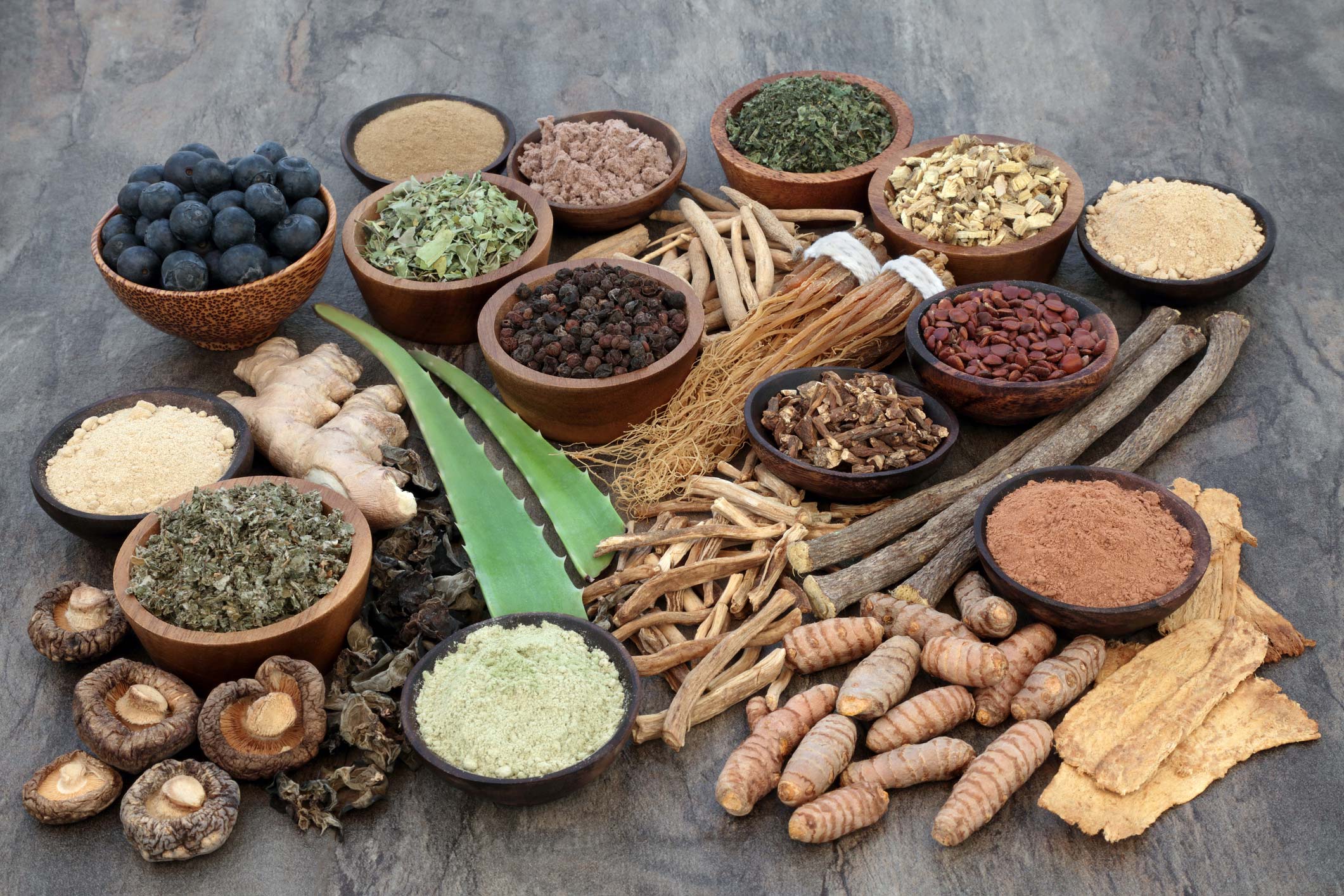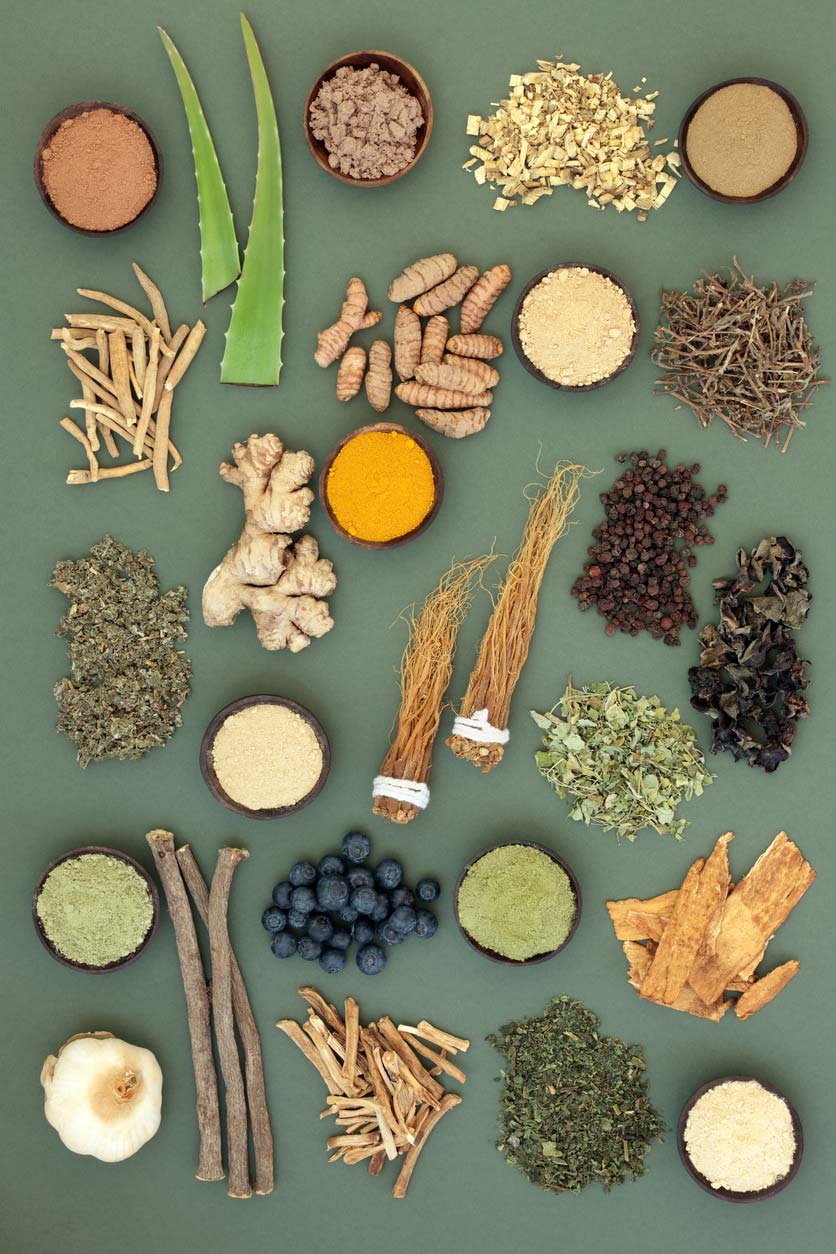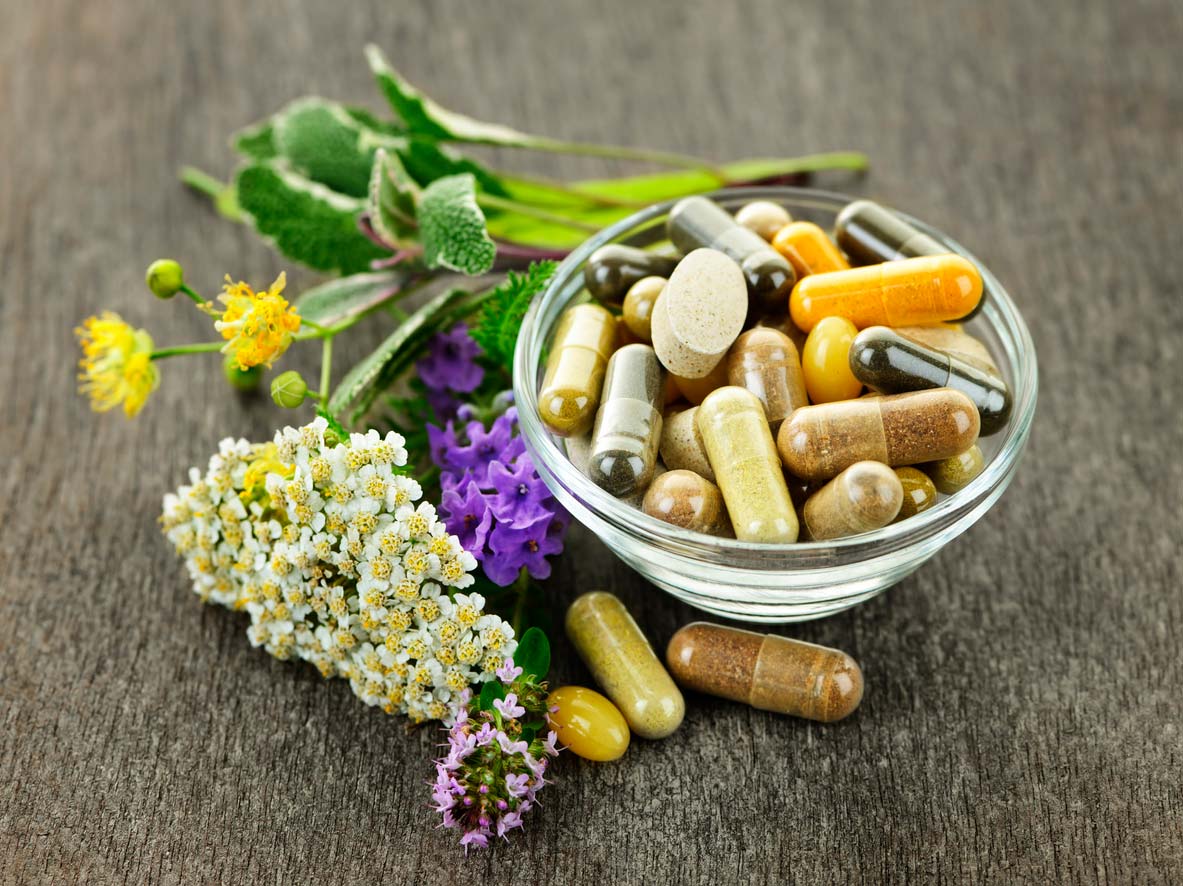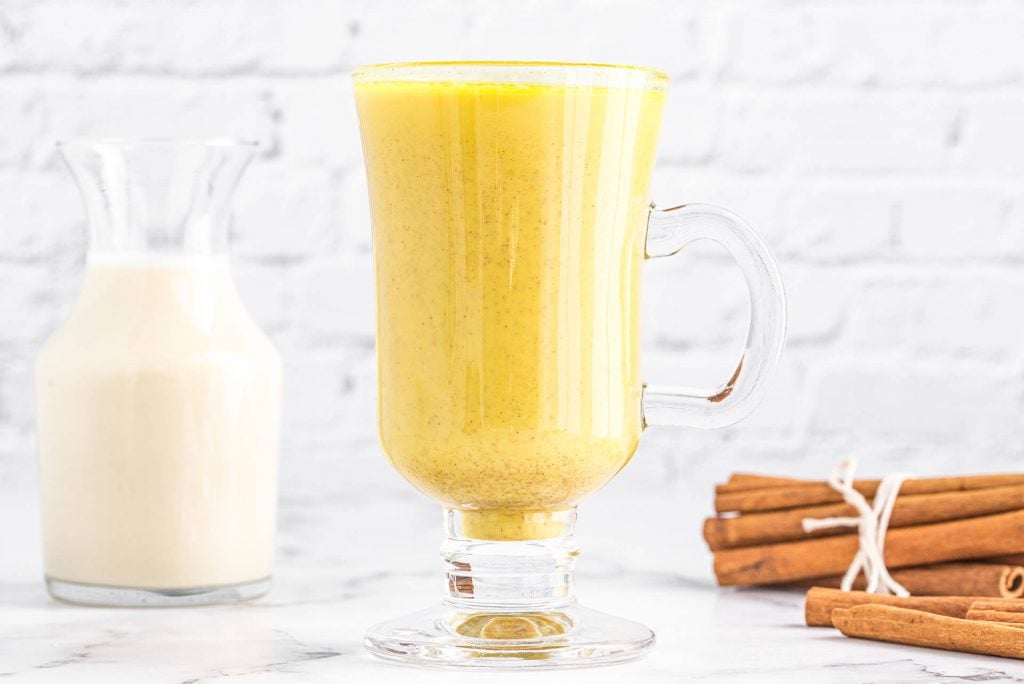It’s no secret that eating plants is good for our health. Even unglamorous veggies like potatoes and ordinary fruits like apples are nutritional powerhouses, providing us with vitamins, minerals, phytonutrients, and multiple forms of fiber. But there are a few plants credited with “above and beyond” powers of healing. Known as “adaptogens,” their popularization in recent years came via wellness-minded celebrities. And adaptogens are gaining momentum in the west as solutions to many of the problems of modern living: low mood, stress, anxiety, depression, and a compromised immune system. Adaptogens are often promoted as safe and natural alternatives to pharmaceutical drugs, although they work complementary to Western medicines as well. So the big question is: Are adaptogens the real deal, or just plain old plants with a big marketing budget?
What Are Adaptogens?
Adaptogens are herbs and plants used to help the body adapt to stressors of all kinds. Each type of adaptogen has its own unique properties and benefits. According to the Russian scientist who coined the term in 1940, N. Lazarev, adaptogens must meet the following criteria:
- They must be non-specific, meaning they help the body to defend against a wide variety of physical, chemical, and biological stressors. For instance, environmental pollution, radiation, infectious diseases, and interpersonal disharmony. In this way, they contradict the medical concept of the “silver bullet”: a drug that treats a single condition without any side effects or unintended consequences. One of the most famous adaptogens, Panax ginseng, gets its species name, Panax, from the same word as “panacea,” or cure-all. In the Western medical tradition, this hasn’t historically been a compliment.
- Adaptogens must support homeostasis, or equilibrium, in the human body. The underlying point here is that the human body contains great wisdom and can deal with most challenges with precision and elegance — if it has full access to its healing potential. By countering the effects of environmental and emotional stressors, adaptogens make the body’s healing potential fully available to meet the challenge.
- They must not cause harm or damage normal human bodily functions. Again, unlike pharmaceuticals that often produce negative side effects, and may create a plethora of new problems even as they manage existing ones, the adaptogens must fundamentally make the body stronger and better able to respond to a wide variety of threats, without weakening or compromising its core systems. They may still have some side effects, but their overall impact on the entire body is beneficial.
Do Adaptogens Work?
Adaptogens have been used for centuries in Indian Ayurveda and Traditional Chinese Medicine (TCM) to treat numerous diseases and health conditions. Take one famous adaptogen: American ginseng. TCM attributes powerful energetic and sex-enhancing effects to the plant — as if it was a cross between coffee, Cialis, and Celexa. The name “ginseng” comes from two Mandarin Chinese symbols, ren and shen, which together translate as “man root.” (If you happen to see a whole root, with its often human-like body and a strategically placed lower-body appendage, you’ll understand the name instantly.)
Today, many alternative, complementary, and holistic practitioners prescribe adaptogens to their patients and clients, to help their bodies retain or regain balance in times of internal or external stress.
While adaptogens haven’t generated anything near the research budget of even modest pharmaceutical drugs, since they’re unpatentable, various research studies and practical applications have shown that plant-originated adaptogens can make an important contribution to human health. For example, different varieties of ginseng have indeed shown support of sexual health and performance, improving erectile function and self-reported sexual satisfaction, increasing sperm count, and in the case of a 1998 study of American ginseng, facilitating what the researchers delicately refer to as “copulatory behavior” in rats.
The legendary benefits of ginseng on male sexuality may be the main reason dried American ginseng root sells for $500 per pound in Asian markets. And it may explain why poaching of the wild form of the plant in Appalachia threatens it with extinction. Although, fascinatingly, the Cherokee believe that American ginseng is a sentient plant, able to hide itself from those not worthy of its blessings. So perhaps it’s just biding its time.
Even though it’s very exciting to learn how powerful medicinal plants may be, much more research is necessary. Clinical applications of plant adaptogens and their specific uses in health care products are still in the preliminary stages. But so far, the evidence is promising.
15 Adaptogen Types and Their Potential Benefits
The main benefit of adaptogens is their protective effect on the body against the toxic effects of stress. Stressors range from physiological, as in pollution or radiation, to psychological, ranging from mild anxiety to crippling fear.
Here are 15 of the most popular and well-researched adaptogens that you might consider adding to your own wellness regimen:
1. American Ginseng
Native to deciduous forests of Canada and the United States, American ginseng (Panax quinquefolius) is a member of the ivy family. While exports to China and other Asian countries are common, American ginseng is different from Asian ginseng (Panax ginseng). American Ginseng often sells in whole root form, as a tea, or as a powdered or encapsulated dietary supplement.
Studied benefits include boosting short-term memory, regulating blood sugar, fighting fatigue, and even protecting against cold and flu, as well as the sexual benefits described in the previous section.
Possible side effects can include itchiness, diarrhea and upset stomach, difficulty sleeping, increased nervousness and anxiety, headaches, and rash. As adaptogen types go, American Ginseng is generally regarded as safe, as long as it is taken in appropriate doses (100-3,000 mg daily) for short periods of time up to 12 weeks. However, it is known to decrease the effectiveness of the blood thinner warfarin. And it may cause a moderate impact on the effectiveness of certain antidepressants and diabetes medications (for more on drug interactions, click here).
2. Siberian Ginseng
Also called Devil’s Shrub, Eleuthero, and Touch-Me-Not, Siberian ginseng (Eleutherococcus senticosus) isn’t actually a species of ginseng. It comes from a North Asian perennial plant and often comes in supplement form as a root extract.
Studied benefits of taking Siberian ginseng include pain alleviation, improving bone health and osteoporosis symptoms, stimulating the immune system, supporting sleep, improving cholesterol levels, and managing bipolar disorder when taken in combination with lithium.
Possible side effects include drowsiness, sadness and anxiety, muscle spasms, and changes in heart rate. Siberian ginseng is likely safe when taken orally for a short period, but it’s not recommended to take it with alcohol, heart medications, diuretics, sedatives, or certain diabetes drugs.
3. Ashwagandha
A small shrub with yellow flowers native to India and North Africa, Ashwagandha (Withania somnifera) is also known as Indian ginseng and winter cherry. One of the most popular adaptogen types, it’s typically used supplementally as an extract or powder made from the plant’s leaves or roots.
Studied benefits include reducing inflammation, improving insulin sensitivity and blood sugar regulation, supporting fertility, increasing muscle mass and strength, lowering cholesterol and triglycerides, anticancer effects, and alleviating depression, stress, and anxiety. Some people report experiencing lucid dreams (being able to control your dreams while you’re in them) after taking Ashwagandha. While others claim that the herb facilitates deep, dreamless sleep.
It is considered as possibly safe when taking 240-300 mg per day for up to three months at a time. But pregnant or breastfeeding women should avoid it as it may cause miscarriage. Other possible side effects include lowering blood pressure and blood sugar, upset stomach, increased thyroid hormone production, and causing an overreaction of the immune system among people with autoimmune conditions.
4. Astragalus
There are over 2,000 species of astragalus, also known as huáng qí or milkvetch. But only two main species of the root (Astragalus membranaceus or Astragalus mongholicus) are used as a supplement. They are often taken orally as a liquid extract, capsule, powder, or tea, and are sometimes used intravenously in the hospital setting. Astragalus is native to China, Mongolia, and Korea, but is now grown around the world.
Studied benefits include increased white blood cell count, anti-inflammatory effects, alleviating effects of chemotherapy, lowering blood sugar, and improving proteinuria among people with kidney disease. However, pregnant and breastfeeding women or people with autoimmune disease shouldn’t take astragalus. It may cause an upset stomach and is known to interact with immune-suppressant medications.
5. Cordyceps
A type of medicinal Chinese mushroom, cordyceps (Ophiocordyceps sinensis) is native to Bhutan, China, Korea, Nepal, Thailand, and Vietnam, but is widely available as a supplement around the world. Cordyceps is often called “caterpillar fungus” due to its long, thin, brown appearance.
Studied benefits of cordyceps include boosting energy and athletic performance, anticancer and anti-inflammatory effects, improving blood sugar, and lowering blood pressure. Possible side effects include nausea, diarrhea, and dry mouth. Generally, the recommendation for people with bleeding disorders or who take blood-thinning medications is that they should avoid taking cordyceps. This adaptogen may also cause an allergic reaction for people allergic to mold or yeast since it is also a type of fungus.
6. Panax Ginseng
Grown in Korea, northeastern China, and far eastern Siberia, the root of Panax ginseng contains powerful compounds called ginsenosides. And it has many medicinal purposes that affect different bodily systems. Studied benefits include improved brain function and memory, respiratory health and reducing symptoms of COPD, boosting energy, supporting sexual vitality, and possibly lowering the risk of getting cold or flu.
While generally considered safe to take for up to six months, Panax ginseng can cause insomnia, interfere with blood clotting, and aggravate autoimmune and hormone-sensitive conditions. It can also cause side effects or interactions when taken in conjunction with alcohol, caffeine, diuretics, antidepressants, or certain diabetes drugs.
7. Goji Berry
Also known as wolfberries and traditionally grown in China, goji berries (Lycium barbarum) are small, red, and often sold in a dried form similar to raisins. Studied benefits include improved focus and sleep patterns, improved fertility, increased energy, better eye health, and improved immunity. However, there is some evidence that goji berries may cause uterine contractions. So pregnant women should avoid taking goji berry products. They may also interact with blood thinners and blood pressure or diabetes medications as well. You can eat goji berries on their own or as a powder added to foods like breakfast cereals, trail mix, or yogurt.
8. Jiaogulan
Also called Southern ginseng, the jiaogulan (Gynostemma pentaphyllum) plant grows in wild parts of Asia, where it’s revered as the “immortality herb.” Its leaf has medicinal uses, primarily to make extracts or tea. Studied benefits include improved cholesterol and blood sugar regulation. While possible side effects include aggravation of autoimmune disease and slowed blood-clotting. Pregnant women shouldn’t take jiaogulan as it may contain compounds that raise the risk of birth defects.
9. Licorice Root
Although best known for its use as a flavoring in a type of candy, you might also find licorice root (Glycyrrhiza glabra) added to herbal teas for its sweet flavor and calming effect. It’s native to Europe and Asia and long ago became a staple in Chinese medicine.
Studied benefits of licorice root include alleviating stomach pain, lowering stress by stimulating the adrenal gland, protecting skin and teeth with its antibacterial and antiviral properties, improving respiratory function by promoting healthy mucus production, and anticancer effects.
Possible side effects include disruption of metabolism, increased blood pressure, swelling and fluid retention, and abnormal heart rate. Experts suggest that licorice extract shouldn’t contain more than 30 mg of glycyrrhizic acid per mL of extract (the amount of glycyrrhizic acid should appear on the ingredient label). Licorice powder use should not exceed 75 mg per day.
10. Rhodiola
An herb that grows best in the cold mountains of Europe and Asia, rhodiola root (Rhodiola rosea), is also called arctic root or golden root. It contains over 140 active compounds, with two of the most potent being rosavin and salidroside. The root’s usage goes back centuries as a treatment for anxiety, fatigue, stress, and depression in Russia and Scandinavian countries. And it’s also thought to protect cells from damage. Other potential benefits include boosting learning, memory, and exercise performance, improving blood sugar regulation, and having anticancer effects.
Taking rhodiola comes with possible side effects, such as dizziness, dry mouth, lowered blood sugar and blood pressure, and aggravation of autoimmune disease. The extract is possibly safe when taken for 6-12 weeks.
11. Magnolia Berry
Magnolia berry is the fruit that comes from the Schisandra chinensis plant. Its one of the adaptogen types that has uses ranging from preventing early aging, stimulating the immune system, and normalizing blood sugar and blood pressure. Studied potential benefits include stimulated liver growth and energy.
Magnolia Berry is not recommended for pregnant women or people with epilepsy. It can irritate the stomach and may reduce the effectiveness of medications that are changed and broken down by the liver, such as celecoxib, diclofenac, fluvastatin, glipizide, ibuprofen, irbesartan, losartan, phenytoin, piroxicam, tamoxifen, tolbutamide, torsemide, and warfarin.
12. Reishi
Reishi (Ganoderma lucidum) is a type of mushroom popular in Eastern medicine. Reishi has a “woody” taste and grows in hot and humid climates in Asia. It’s thought to have immune-boosting and anticancer effects and has applications in some treatments of prostate cancer. Other potential benefits include fighting fatigue, boosting HDL “good” cholesterol levels, and lowering high blood sugar.
Reishi comes with several possible side effects, too, including nose, throat, and mouth dryness, upset stomach, nosebleeds, and bloody stools. It may increase the risk of bleeding in people with low blood pressure and bleeding disorders. Reishi is considered possibly safe when used for up to one year, but may interact with blood pressure or blood clotting drugs.
13. Maca Root
Also called Peruvian Ginseng, maca root (Lepidium meyenii) is native to Peru and grows high in the Andes mountains, though some farmers are now growing it in Brazil, Bolivia, and China. Maca is a cruciferous vegetable with an edible root. But the root is most popular in its powdered form as a supplement. Potential benefits of maca root include improved mood, sun protection, improved bone and brain health, fertility, reduced menopause symptoms, and lower prostate cancer risk. Maca root appears to have minimal side effects but could increase thyroid hormone due to its iodine content.
14. Tulsi/Holy Basil
Closely related to the culinary basil you might use to make pesto, holy basil (Ocimum sanctum) is native to India and Southeast Asia. It contains compounds thought to have adaptogenic properties, such as pain-relieving eugenol, anti-inflammatory ursolic and rosmarinic acids, waste-removing apigenin, the antioxidant lutein, and stress-reducing ocimumosides A and B. It’s commonly used for alleviating symptoms of cold and flu. But other potential benefits include boosting upper respiratory immunity, lowering anxiety, reducing cholesterol levels, and improving metabolic syndrome.
As to possible side effects, tulsi may have the potential to lower blood sugar too much, which could be especially problematic for diabetics and pregnant women. Also, according to the World Health Organization, people who are on pain medications like acetaminophen have a greater risk of liver damage if they also consume tulsi regularly.
15. Turmeric
Best known for its bright yellow coloring and use in Indian cuisine, the spice turmeric (Curcuma) is a potent antioxidant with likely adaptogenic properties. Turmeric contains the active compound curcumin, which is renowned for many health benefits. Potential benefits of using turmeric include alleviating cold and allergy symptoms, reducing depression, and relieving inflammation and associated pain. Potential side effects include irritating existing acid reflux or gallbladder problems, lowering blood sugar too much, slowing blood clotting, and inhibiting iron absorption.
Turmeric is likely safe when taken in doses of eight grams daily for two months or three grams daily for three months. Many people in India consume it almost every day as a seasoning and experience no known negative effects and many potentially positive ones.
Where to Find Adaptogens
Adaptogens are fairly easy to find, as many online retailers sell them. You may also find them in natural and health food stores, some grocery stores and pharmacies, supplement stores, and some Asian markets. If you’re not sure where to start, this Adaptogen Blend Mix from Four Sigmatic is a great choice.
How to Use Adaptogens
Most adaptogens come in a powdered or capsule form, like other herbs or supplements. Tinctures, teas, and powders you can mix into drinks like smoothies, tea, coffee, or golden milk are also common. Some people enjoy mixing them into soups, sauces, or sprinkled over other meals, too. There’s no “right” way to consume adaptogens, although if you’re using them as a supplement, you should make sure to follow the instructions on the bottle to ensure proper usage and dosing. Some adaptogens may fare best when refrigerated, while others need a cool, dry place like a pantry.
There are also considerations as to how to incorporate adaptogens into your daily routine. Stimulating herbs should be taken during the day to prevent them from potentially interrupting your sleep pattern or making it difficult to fall asleep at night. Depressant adaptogens are generally better taken in the evening.
It’s also best to take adaptogens under the supervision of your doctor or health practitioner. Many holistic doctors, naturopaths, chiropractors, and acupuncturists will prescribe adaptogens and will be able to guide you to use them to your best advantage.
You can take some adaptogens every day, or even more than once per day. But depending on the adaptogen and the dose, some health professionals recommend taking one day off each week, one full week off every six weeks, and one month off every six months. While adaptogens are potent compounds, they can take a while to show effects. Including these breaks in their usage can help them to retain their effectiveness over time.
Adaptogen Recipes to Boost Your Health
1. Golden Milk
Get ready to soothe your soul while supporting your immune system and reducing inflammation with this creamy and earthy golden milk. Sip on the healing milk in the morning as a replacement for coffee or as a calming beverage before bedtime, preparing your body for deep sleep.
2. Coconut Chia Maca Bites
Start your day off healthy or get an afternoon boost with some natural energy from these high fiber, antioxidant-rich, and maca-infused bites. Also, they’re super easy to make, which makes them doubly delightful!
3. Spiced Apple Carrot Ginger Adaptogen Soup
This soup is extremely delicious and healing on its own, but when you add immune-enhancing mushroom powder to it, the level of nourishment goes through the roof. Made with organic apples, carrots, ginger, onion, celery, mustard seed, and turmeric, this soup is perfect for year-round immune-support.
Should You Use Adaptogens?
Many people report improved health through adaptogens. Whether you should use them is a personal decision you should make based on your own best judgment, and likely in consultation with your health care professional. Some adaptogens have strong evidence to support their effectiveness. But many need further study to determine best uses and efficacy. Furthermore, many of them do have potential medication interactions. You should weigh the benefits and potential side effects of any adaptogen you’re considering trying. And remember, they’re not a cure-all. Adaptogens are meant for use as a complementary resource and may help provide relief for a variety of ailments.
Unlike most prescription drugs, well-used adaptogens can provide a broad spectrum of benefit to your body, mind, and even your spirit.
Tell us in the comments:
- Have you ever tried an adaptogen? What was your experience?
- Do you have any favorite adaptogen-featuring recipes?
Feature image: iStock.com/marilyna







